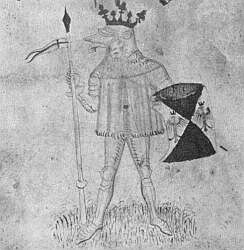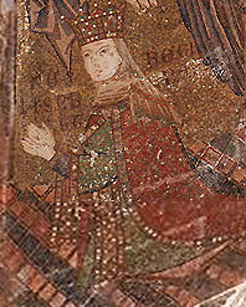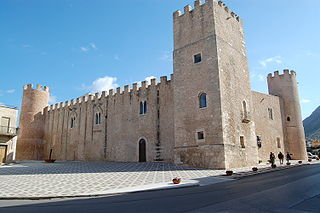Related Research Articles

Maria was Queen of Sicily and Duchess of Athens and Neopatria from 1377 until her death.

Martin I of Sicily, called "The Younger", was King of Sicily from his marriage to Queen Maria in 1390 until his death.

The Chiaramonte are a noble family of Sicily. They became the most powerful and wealthy family in Sicily. In the 13th century the marriage of Manfredi Chiaramonte to Isabella Mosca, united the two Sicilian counties of Modica and Ragusa. Around 1307–1320, the couple built the family seat, the Palazzo Chiaramonte, in Palermo.
Bartholomew "Tristan" de Clermont-Lodève, Count of Copertino, was a French-born knight who married Catherine Orsini del Balzo, youngest daughter of Mary of Enghien and Raimondo Orsini del Balzo, Prince of Taranto. He was the father of Isabella of Clermont, Princess of Taranto, the first consort of King Ferdinand I of Naples.
Louis the Child was King of Sicily from 15 September 1342 until his death. He was a minor upon his succession, and was under a regency until 1354. His actual rule was short, for he died in an outbreak of plague the next year. His reign was marked by civil war.

The Ventimiglia were a noble family of Liguria, now in Italy. Descendants of the family held positions and titles of nobility in Sicily in Mediaeval times and later.
Ventimiglia is a city in Liguria, Italy near the French border.
Naso is a town and comune in northeastern Sicily, Italy, administratively part of the Metropolitan City of Messina. It had 4,070 inhabitants in 2011.

Elizabeth of Carinthia (1298–1352) was Queen of Sicily by marriage to Peter II of Sicily. She was the regent of Sicily during the minority of her son Louis, King of Sicily from 1348 until her death in 1352.
Antonia of Baux, was an Italian noblewoman member of the French House of Baux and by marriage Queen consort of Sicily, Duchess consort of Athens and Neopatras.
The County of Malta was a feudal lordship of the Kingdom of Sicily, relating to the islands of Malta and Gozo. Malta was essentially a fief within the kingdom, with the title given by Tancred of Sicily the Norman king of Sicily to Margaritus of Brindisi in 1192 who earned acclaim as the Grand Admiral of Sicily. Afterwards the fiefdom was passed from nobleman to nobleman remaining as a family possession in a few instances. It was used mainly as a bargaining tool in Sicilian politics leading to a rather turbulent history. The fiefdom was elevated to a Marquisate in 1392 and either title was no longer used after 1429.
Niccolò Speziale di Noto ( was the Viceroy of Sicily in 1423–1424, and 1425–1432.

Giovanni II Ventimiglia y Moncada, 6th Marquis of Geraci was a Sicilian aristocrat, a member of the prominent House of Venitmiglia.
The Treaty of Villeneuve (1372) was the definitive agreement that ended the dispute between the House of Anjou and the House of Barcelona over the Kingdom of Sicily that began ninety years earlier in 1282. Its final form was approved by Pope Gregory XI in a bull issued at Villeneuve-lès-Avignon on 20 August 1372, and it was ratified by Queen Joan I of Naples and King Frederick IV of Sicily on 31 March 1373 at Aversa, in Joan's kingdom, in front of the papal legate, Jean de Réveillon, Bishop of Sarlat.

The Castle of the Counts of Modica is a medieval castle situated in the town centre of Alcamo, in the province of Trapani, Sicily, southern Italy.

The House of Gravina, then Gravina Cruyllas, was a noble family of Norman origins, with roots stretching back to Rollo, the first ruler of Normandy.
The Di Sangro family is an Italian noble family.
The Cesina family is an Italian family of Roman-Lombard origin.
Andrea Chiaramonte was a representative of the Sicilian nobility in the 14th century.
References
- ↑ Memorie delle famiglie nobili delle province meridionali d'Italia,Volumes 1-2, by Count Berardo Candida Gonzaga (1875); page 197.
- ↑ Berardo Candida Gonzaga; page 201.
- ↑ Teatro genologico delle Familie .. de regni Sicilia, by Filadelfo Mugnos, Messina, 1671, page 476.
- ↑ Della storia di Sicilia, by the abbot Francesco Maurolico, edited by Girolamo Di Marzo Ferro, Etienne Baluze, Giacomo Longo, 1849, page 270.
- ↑ Much derived from Italian Wikipedia.